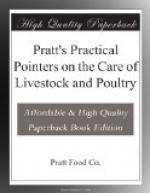[Illustration: HOLSTEIN COW]
As soon as the change from whole to skim-milk is begun, some substitute should be added to replace the fat withheld by reducing the amount of whole milk fed. Ground flax or oil-meal is the best. It is generally fed in the latter form. In some instances the oil-meal is put directly into the milk beginning with a heaping teaspoonful and gradually increasing the quantity. A too lax condition of the digestion would indicate that an excessive amount was being fed. Later the meal may be more conveniently fed when mixed with other meal.
-------------------------------------------------------
---------- Riverdale, Md.
Very much pleased with
results of Pratts Animal Regulator during
the present period of
my cows breeding. An extraordinary strong
calf and the mother
in fine condition.
WM. C. GRAY._ ------------------------------------------------------------
-----
As soon as the calves will eat meal it should be given to them. No meal is more suitable at the first than ground oats and wheat bran. A little later whole oats will answer quite well. To calves grown for dairy uses they may form the sole grain food. If the calves are to be grown for beef, some more fattening food, as ground corn, or ground barley, should be added to the meal. For such calves, equal parts of bran, oats whole or ground, and ground corn, barley, rye, or speltz are excellent. Until three months old they may be allowed to take all the grain that they will eat. Later it may be necessary to restrict the quantity fed. Calves for the dairy must be kept in a good growing condition, but without an excess of fat. The meal should be kept in a box at all times accessible to the calves and should be frequently renewed. Grain feeding may cease when the calves are put upon pasture.
As soon as the calves will eat fodder it should be given to them. Fodder gives the necessary distention to the digestive organs, which makes the animals capable of taking a sufficient quantity of food to result in high production. Alfalfa, clover-hay, and pea and oat hay are excellent, provided they are of fine growth and cut before they are too advanced in growth. If field roots can be added to the fodder the result in development and good digestion will be excellent. Any kind of field roots are good, but mangels, sugar beets, and rutabagas are the most suitable because of their good keeping qualities. They should be fed sliced, preferably with a root slicer, and the calves may be given all that they will eat without harm resulting.
The duration of the milk period more commonly covers three to four months with calves that are hand fed, but it may be extended indefinitely providing skim-milk may be spared for such a use. Such feeding is costly. Calves reared on their dams are seldom allowed milk for more than six or seven months, save when they are reared for show purposes.




